Related Research Articles

The Coptic Orthodox Church, also known as the Coptic Orthodox Patriarchate of Alexandria, is an Oriental Orthodox Christian church based in Egypt. The head of the church and the See of Alexandria is the pope of Alexandria on the Holy Apostolic See of Saint Mark, who also carries the title of Father of fathers, Shepherd of shepherds, Ecumenical Judge and the 13th among the Apostles.

Mark the Evangelist, also known as John Mark or Saint Mark, is the person who is traditionally ascribed to be the author of the Gospel of Mark. Modern Bible scholars have concluded that the Gospel of Mark was written by an anonymous author rather than an identifiable historical figure. According to Church tradition, Mark founded the episcopal see of Alexandria, which was one of the five most important sees of early Christianity. His feast day is celebrated on April 25, and his symbol is the winged lion.
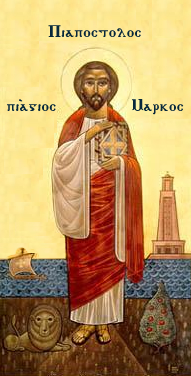
The Patriarch of Alexandria is the archbishop of Alexandria, Egypt. Historically, this office has included the designation "pope".
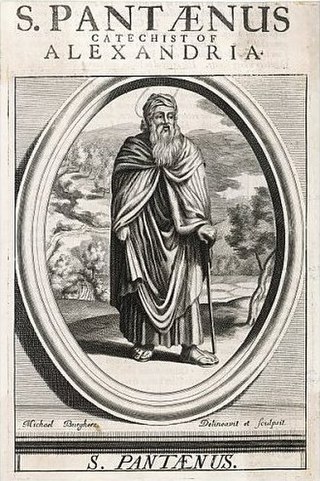
Saint Pantaenus the Philosopher was a Greek theologian and a significant figure in the Catechetical School of Alexandria from around AD 180. This school was the earliest catechetical school, and became influential in the development of Christian theology.

Menas of Egypt, a martyr and wonder-worker, is one of the most well-known Coptic saints in the East and the West, due to the many miracles that are attributed to his intercession and prayers. Menas was a Coptic soldier in the Roman army martyred because he refused to recant his Christian faith. The common date of his commemoration is November 11, which occurs 13 days later on the Julian calendar.
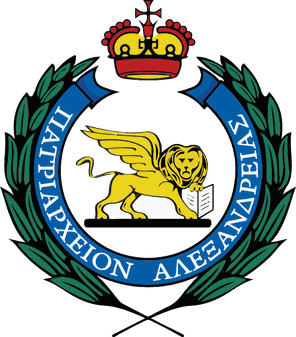
The Greek OrthodoxPatriarchate of Alexandria and all Africa, also known as the Greek Orthodox Church of Alexandria, is an autocephalous patriarchate that is part of the Eastern Orthodox Church. Its seat is in Alexandria and it has canonical responsibility for the entire African continent.

Theodore Stratelates, also known as Theodore of Heraclea, was a martyr and warrior saint in the Eastern Orthodox, Catholic and Oriental Orthodox Churches.
Saint Dasya the Soldier or Daysa the Egyptian, was a Christian martyr of the third century. He was born in Tanda, Egypt, and served as a soldier in the Roman army. Refusing to deny Christ, Dasya was tortured by Arianus, governor of Ansena, who inflicted great tortures on him, eventually cutting off his head.
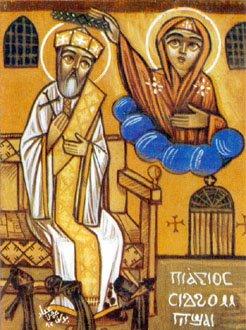
Sidhom Bishay was a Coptic Orthodox martyr and saint.

Christianity is the second largest religion in Egypt. The vast majority of Egyptian Christians are Copts. As of 2019, Copts in Egypt make up approximately 10 percent of the nation's population, with an estimated population of 9.5 million or 10 million. In 2018, approximately 90% of Egyptian Christians were Coptic Orthodox.
Saint John of Senhout is an Egyptian saint from the 4th century AD.

Saint Mark's Coptic Orthodox Cathedral is a Coptic church in Alexandria, Egypt. It is the historical seat of the Pope of Alexandria, the head of the Coptic Orthodox Church.
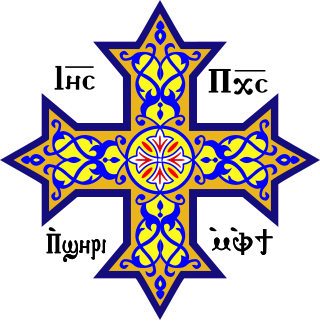
Coptic history is the part of the history of Egypt that begins with the introduction of Christianity in Egypt in the 1st century AD during the Roman period, and covers the history of the Copts to the present day. Many of the historic items related to Coptic Christianity are on display in many museums around the world and a large number is in the Coptic Museum in Coptic Cairo.

October 30 - Eastern Orthodox liturgical calendar - November 1

Mercurius was a Roman soldier of Scythian descent who became a Christian saint and martyr. He was born in the city of Eskentos in Cappadocia, in Eastern Asia Minor. According to Christian tradition, he was the soldier who killed Julian the apostate during his campaign in Persia. Saint Mercurius was also widely known by his Arabic-language name Abu-Sayfain, Abu-Sifin or Abu-Sefein in Egyptian Arabic which means "father of two swords", referring to the second sword given to him by the Archangel Michael.

Saint Demiana and the 40 virgins was a Coptic martyr of the early fourth century.

Abanoub or Abanop or Abanoub Al-Nahisy, is a 4th-century Christian saint and martyr from Egypt. His name means Father of Gold in Coptic. He was born in Nehisa in the Nile Delta to Christian parents. Abanoub was 12 years old when he was killed and beheaded, after being tortured for refusing to leave Christianity. His feast day is July 31. His relics are preserved in St. Virgin Mary and St. Abanoub Churches in Sebennytos, Egypt. His title is often The Child Martyr.

The Liturgy of Saint Cyril is one of the three Anaphoras used at present by the Coptic Catholic Church and the Coptic Orthodox Church and it retains the liturgical peculiarities which have originated in the early Christian Egypt, thus forming the core of the historical Alexandrian Rite. When reference is made to its Greek Byzantine Rite version, this text is usually known as Liturgy of Saint Mark.
References
- ↑ Murphy, John F.X. "Sts. Gordianus and Epimachus." The Catholic Encyclopedia Vol. 6. New York: Robert Appleton Company, 1909. 26 November 2021
 This article incorporates text from this source, which is in the public domain.
This article incorporates text from this source, which is in the public domain. - ↑ "Martyr Epimachus of Alexandria, Egypt", Greek Orthodox Archdiocese of America
- 1 2 "Apostle Epίmakhos of Alexandria", Orthodox Church in America
- ↑ "Apostle Stachys et al.", Basilica.Ro News Agency
- ↑ "Commemorations for Bashons 14", St. Mark's Coptic Orthodox Church, Jersey City, NJ
- ↑ "Orthodox Saint Epimachus History and Name Day Information", Greek Boston